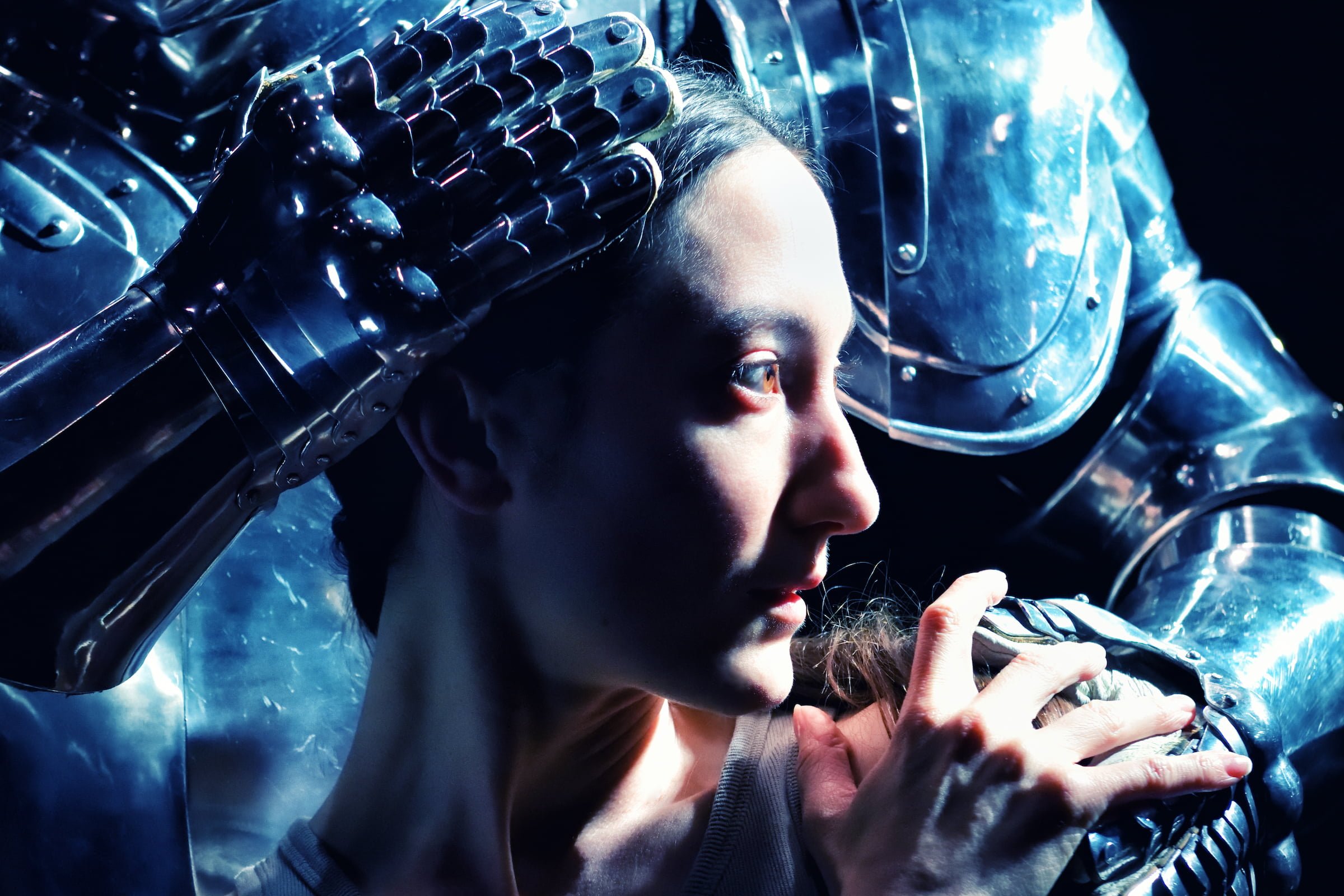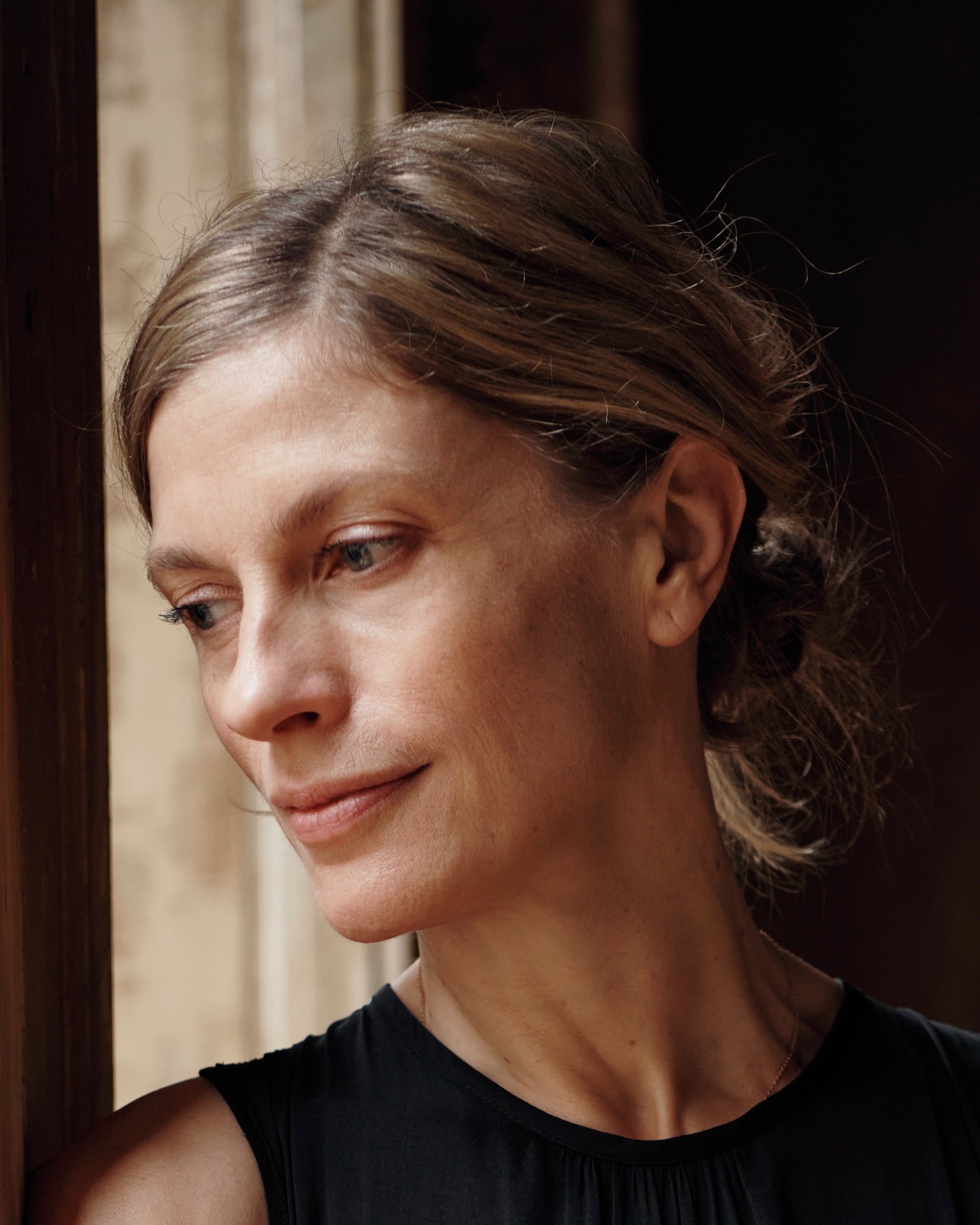Crystal Pite navigates multiple planes of reality and conflict for Assembly Hall
Working again with theatre artist Jonathon Young, Vancouver dance star makes sophisticated play out of medieval re-enactment, Robert’s Rules, and the spoken word
Renée Sigouin in Assembly Hall. Photo by Michael Slobodian, for DanceHouse
DanceHouse presents Assembly Hall from October 25 to 28
OVER THE PAST DECADE, Crystal Pite and Jonathon Young have crafted intricate hybrids of dance and theatre that dazzle in the way they melt time and space, warping and stretching language.
Their award-winning, world-travelling works operate on multiple, mind-expanding planes of reality. In the case of their new Assembly Hall, the duo plays with elements as profound and layered as anything Pite and Young have created so far. On the surface level, a group of medieval re-enactors have gathered for their AGM at a local community hall. But conflict ensues, and mythical ancient forces are awakened.
Now imagine working inside these multiple planes, acting as puppet master to all those moving parts, starting with a script written by Young and recorded by actors, then re-edited and embodied by dancers playing the characters. Add to that infinitely detailed choreography, countless technical cues, haunting music, otherworldly lighting, and more theatrical magic. It’s a lot to pull together with just a few weeks to the world premiere at the Vancouver Playhouse, care of DanceHouse.
“I’m in the deep swamp of the thing,” Pite tells Stir with a laugh, speaking on a Saturday morning away from the whirlwind of rehearsals. “It’s that terrifying part of the process where everything feels like a conflict between what seems to be possible and what seems to be impossible. You know? There are so many possibilities and the territory is so rich that I’m overwhelmed right now by what the show could give.”
If fans of Pite and her Kidd Pivot company know one thing, it’s that the choreographer has a history of pulling off the seemingly impossible. In Betroffenheit, the downward spiral of grief morphed into dark clown cabarets and rooms without exits. In Revisor, farce edged into nightmare, as dancers mimed and acted out the words to Nikolai Gogol’s 1836 political satire The Inspector General—until it all glitched and fragmented into a new, hallucinatory dimension.
As always with the work of Pite and Young, many of the details of their new Assembly Hall are left to surprise: a new trailer shows dancer Renée Sigouin dancing gently with a figure in gleaming knight’s armour, his hard, metal-gloved hands precariously cupping her delicate head. (See the video at bottom.)
Pite explains that the piece operates on multiple levels—and as usual for her practice, stretches and transforms to embrace expansive themes.
“We’re interested in working on a couple of different planes,” she says of herself and Young. “On what we’re calling the 'surface layer’, there is this annual general meeting of a board of directors of a group that are medieval re-enactors. But then there’s the inevitable dysfunction and challenge of a group of people to come together, to overcome division and overcome obstacles. And we got really interested in combinations of the tension between our human need to gather and find unity and the kind of impossibility of maintaining it.
“So of course it’s a small little scene of a community hall with this little group of a board of directors,” she continues, “but if you zoom out it has these larger implications to the broader question of conflict and what that means when it gets cranked up and amplified—when it gets to be larger forces in the world.”
It’s profound terrain, but at least Pite is not alone in her late-in-the-process struggles. Pite and Young by now work together instinctually, their collaborations spanning not just the dance-theatre melds of Kidd Pivot, but commissions for companies like Nederlands Dans Theatre. (Its cleverly taut The Statement, an exploration of office-speak that features dancers clambering over a boardroom table, returns to Ballet BC in March.) The duo has found endless inspiration in exploring the mix of spoken script and movement.
For Assembly Hall, eight actors have recorded a script that’s amplified as a kind of rhythmic soundtrack all its own, the dancers onstage becoming characters.
“Our collaboration has taken on some different versions over the years, but I just love working with him. He’s an incredible mind—a very nimble mind,” Pite reflects of Young. “That in itself is a gift—to have someone to challenge me and to try to keep up with him is a great ride. And it’s nice to not be alone, too. Of course I have the performers and I have the design team, but to not be alone in conceiving and thinking about what the show wants to be is really wonderful. It’s always easy, in a sense, in terms of our working relationship, and then in other ways it’s like a game or a puzzle working with him—it feels really potent and fruitful.
“We’re still both really interested in the language and the body, and what does it mean to embody text, and what are the limits of text and limits of choreography, and to see if we can transcend those limits through each other’s skills and knowledge,” she adds.
Crystal Pite. Photo by Rolex by Anoush Abrar
As Young and Pite have progressed, they’ve engaged in increasingly sophisticated play around words and their meanings. In the case of Assembly Hall, the two became fascinated with the language of Robert’s Rules of Order—the picky points that have provided common procedures for debate within governments and board meetings for well over a century.
“There’s always somebody in the group that knows it so well,” Pite says with a laugh. “We wondered if it maybe could be an organizing principle for a show structurally. And there’s also such great language within it, like ‘motion to dissolve’, and ‘I move’—so it already has this kind of rich language that we thought could be an interesting thing to unpack inside choreography.”
That language offers multiple meanings—and allows the pair to “dissolve” the lines between defined reality and fantasy. It’s something Pite refers to as “slippage between worlds”. In Assembly Hall, a mythical underworld runs in parallel to the structures and conflicts of the surface meeting. And you can expect those forces to mind-blowingly shift ideas of time and place—and get close to tackling the larger mysteries of the universe.
“What do those conflicts, structures, and conversations translate into when we go into more stylized and abstract territory—when we go down into the deeper parts of ourselves and of our world and our stories?” Pite wonders. “And because the medieval re-enactors are a sort of interface, it’s a very easy journey to get from the surface world at a community hall to the unleashing of mythic forces and great battles in the other planes.”
As ever, Pite is interested in larger questions of existence and connection—and the kind of tension between unity and conflict that resonates in a world where two wars rage overseas.
“As humans, it seems like we’re always divided and unity seems impossible, and yet unity seems to be a constant need,” Pite reflects. “And I think that these structures, like Robert’s Rules and democracy itself, are meant to hold us in a state of unity and make things fair and clear, and yet they’re also meant to have flaws, just as humans have flaws. I find it quite beautiful when humans are at their best—when they’re unified and working together and they’re in community and they’re in connection, it’s quite moving. And the opposite is also true. So I think I want the show to live in that question. A work of theatre is also an expression of that: of human beings working together to share something around a story or around an idea or a question. And so I guess our show is a paradigm of that.”
As Pite makes her way through this “deep swamp” of ideas, she is surrounded by familiar collaborators from her other masterworks—most of them Vancouver-based. Owen Belton, Alessandro Juliani, and Meg Roe have created the composition and sound design; her partner Jay Gower Taylor conjures the sets; Cybèle Young takes on visual/video design; Tom Visser creates the lighting design; and Nancy Bryant heads up costumes. Many of her eight, dynamic dancers—Brandon Alley, Rakeem Hardy, Gregory Lau, Doug Letheren, Rena Narumi, Ella Rothschild, and Sigouin—have starred in her other work, with Ballet BC alumna Livona Ellis joining Kidd Pivot for the first time.
There’s also a certain comfort that comes in a premiere on the Vancouver stage, at home in B.C. Her last few works have debuted in major European dance halls. Her epic, three-part Light of Passage, set to Henryk Górecki’s Symphony of Sorrowful Songs and embracing themes of refugees and children’s rights, premiered at London’s Royal Opera House to glowing reviews, moving to the Norwegian National Ballet last spring. At Nederlands Dans Theater, she’s in the midst of a four-year-long collaboration with theatre artist Simon McBurney and his company Complicité—a triptych of pieces that will be complete in 2025. After its debut here, Assembly Hall embarks on a national tour to Ottawa, Montreal, Toronto, and Quebec City, and Europe after that. But for now, she’s happy to be assembling on familiar ground.
“It feels like coming home to family and being surrounded by people I can really trust,” Pite tells Stir. That must help when sometimes your work feels like a thrilling leap into the unknown.















